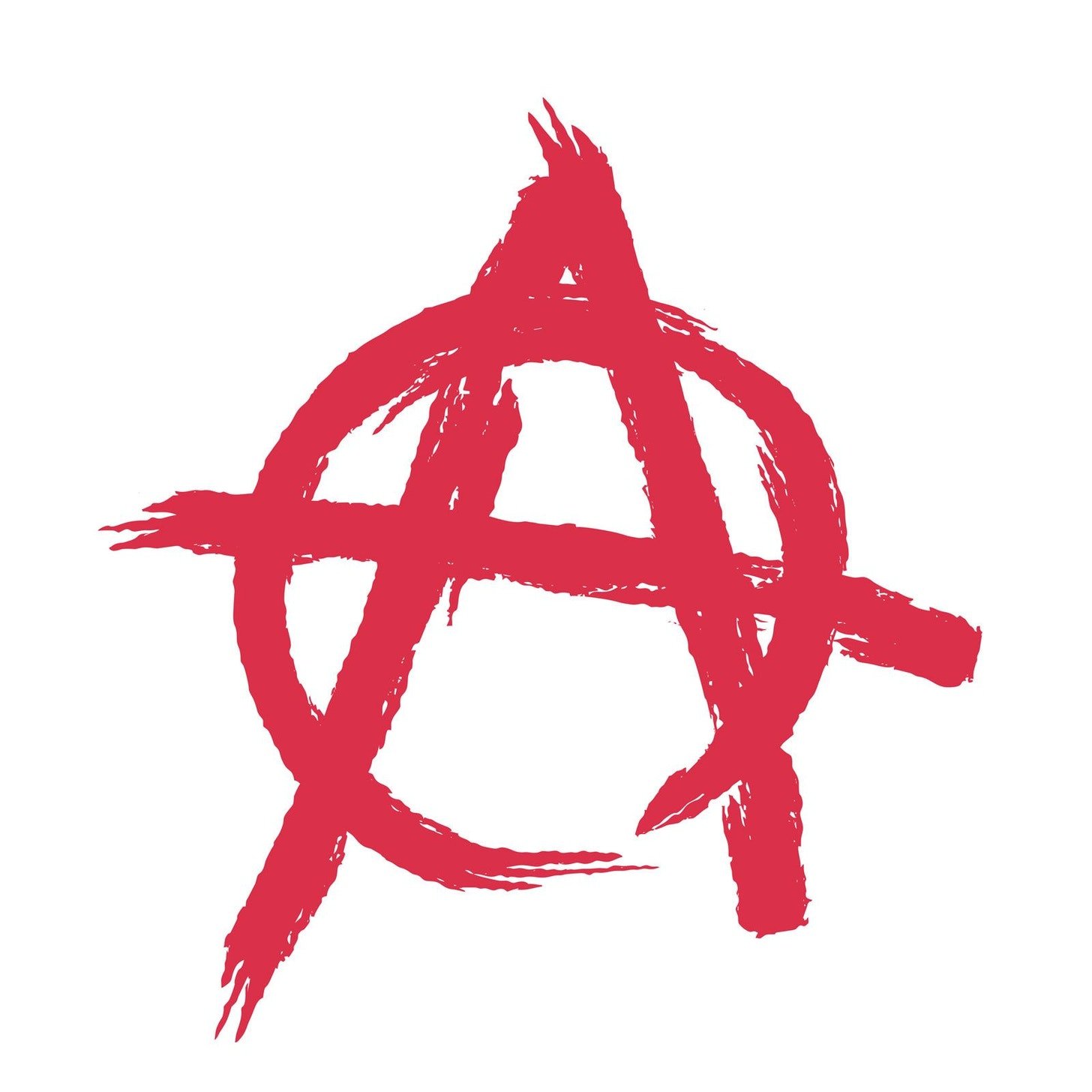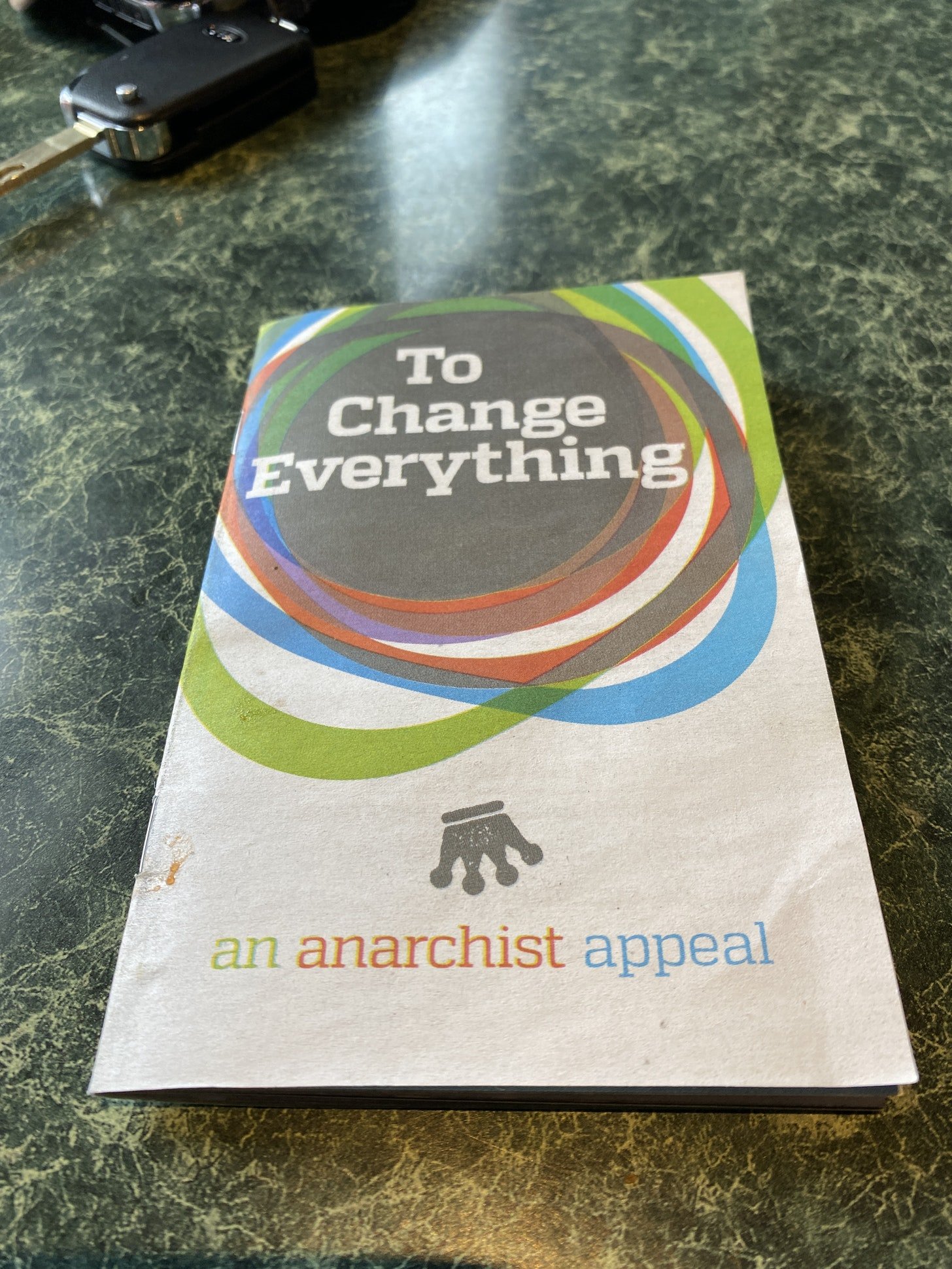Have I found a group I can get along with???
In grade 9 a friend showed me the “anarchy” symbol – it was probably on his jacket –and he explained that it meant “no authority.” That appealed to me a lot: I took to drawing and thinking about it, wondering why we DID have authorities. I thought people could do better if they were unrestrained. (Thought in a grade 9 way.)
At some point, the friend saw my stylized anarchy logo and corrected my explanation – a clear misapprehension of the concept. It’s not a utopian idea, he said (in a grade 9 way); it’s graffiti, it’s tough and angry. He was a poseur of the first order,* but what did I know? I moved away from the idea and the symbol, and he arranged it aesthetically among the badges on his jacket.
*I’m not judging his grade 9 self – god forbid. He remained this way forever, and never met anything he didn’t want to pose next to. Some people are like that.
The Right to Coerce?
About three decades later, I would revisit my position again after watching an interview with Noam Chomsky, whom I love a lot. In it he described himself as “essentially an anarchist,” and defined it as a belief that all coercion needed to be justifiable and justified to be valid. I don’t have the exact quote; it was a long time ago. That’s what I took away from it, and I felt really grateful for the idea, which put words on my own unnamed, lifelong position against dumb authority.
If I’d been instinctively rebellious as a teen, in my 20s (and on) I sought order, sought legitimate ideas that helped me make sense of the world. I gathered them like nuts in the forest, incorporating good explanations into my life and mind. (I am a messy person with high philosophical and emotional demands, and so did not thrive in the footnote scenario of university. Looking for the exact quote is a distraction – I’m trying to tell you something here, I would think. I still do. Apologies.)
“All coercion must be justified” settled in along with “Mean people suck,” which I’d gotten from a sticker, and “You are responsible for this one life you have,” which I’d gotten from Sartre, and “Kids don’t need to be bossed around constantly” from a Native American literature class in uni. I’ve never actually written them down as I’m doing right now – I should do that sometime.
Anarchist!
So am I an anarchist? I started to wonder. I am not a joiner by any stretch. To truncate a Marx quote: I wouldn’t want to belong to any club. I’ve always found social pressure (usually to conform) annoying. I have a nice, scattered, particular social group that I mostly see one on one. I don’t play team sports. I’m not mean about it – I’m just this way. So I had no interest in looking for an “anarchist” community to explore, and didn’t care what other people who might be anarchists thought. I tucked the idea away.
Then, last month, I was in San Francisco with Marjan, walking around in the Haight-Ashbury area, and found Bound Together, an Anarchist Collective Bookstore, all black and dusty, filled with shelves of books, zines, T-shirts and pamphlets and stickers and posters. Every one of them I agreed with. They were all concerned with big things – saving the planet, undoing the extractive system, solving racism, helping kids. I couldn’t buy any more books – I’m travelling and have already picked up too many – but we bought a couple of little zines and pamphlets in the twice-folded paper format. One I haven’t read yet was about Iran’s recent history; the other I have read, and it is why I’m writing this.
I have long considered creating the little book I needed when I was a teen – advice about how to survive and thrive, what to expect from adulthood, how to know what was right and wrong. I draft it all the time. I’m currently working on one about how to manage the feelings and situations of climate change. I never finish these – they seem too big, too easily bad, and I’m a person without authority, with no mentionable letters after my name. I’m not worthy, etc.
But this zine had great advice out the wazoo! It’s called To Change Everything: An Anarchist Appeal. It is the creation of a collective called CrimethInc., “An international network of aspiring revolutionaries.”
It is a quick read, very clearly and practically written, and it dives immediately into the meat of things (bad mental image). Every second page is a new chapter, so that if one were in a hurry, one could flip through the title pages and get the entire idea, in bullets.
Here is that whole list:
To change anything, start anywhere
Start with self-determination
Start by answering to ourselves
Start by seeking power, not authority
Start with relationships built on trust
Start by reconciling the individual and the whole
Start with the liberation of desire
Start with revolt
The problem is control
The problem is hierarchy
The problem is borders
The problem is representation
The problem is leaders
The problem is government
The problem is profit
The problem is property
The accompanying pages have maybe a hundred words each, but they explain the big ideas well. The last chapter has this title, which is very compelling: “The last crime.” It asks the reader to envision the next thing, the thing after this. And there’s a short glossy page describing the terms Anarchy, Anarchism and Anarchists. Anarchy is:
what happens wherever order is not imposed by force. It is freedom: the process of continually reinventing ourselves and our relationships.
Any freely occurring process or phenomenon – a rain-forest, a circle of friends, your own body – is an anarchic harmony that persists through constant change. Top-down control, on the other hand, can only be maintained by constraint or coercion: the precarious discipline of the high-school detention room, the factory farm in which pesticides and herbicides defend sterile rows of genetically modified corn, the fragile hegemony of a superpower.
You’ll have to trust me to be honest here (but I suppose that is always true): I neverread philosophical treatises without a litany of complaints. I’m an almost hostilereader when it comes to worldviews or strategies. But with this little book, I have nothing to object to. I read it fast and exclaimed to Marjan, “This is AWESOME. I love this!” I’ve been thinking about it all month. I feel totally inspired by it.
Note: The whole thing is yours for free at tochangeeverything.com. I’m considering getting a bunch of paper copies to give friends (available for the cost of postage – I love it).
Fake Humanist
I lied: I did sort of secretly “join” a group called “Humanists” after learning about it, after finding out Kurt Vonnegut was a member (maybe the head at one point?). I never bought a book about it, though, and never looked up a website. Their basic idea just made sense, and I loosely flirted with adopting the label. (Nobody ever asks you, do they, so I never had to really say “I’m a humanist.”)
But maybe I’m an anarchist? I’ve gleaned over the years that Anarchism had been a legitimate cause for a lot of leftie intellectuals in the first part of the 1900s, and that they’d been written out of the conversation at some point. It feels funny to think about after this much time. It feels nice to learn that me and my grade 9 self share something in the values department. But in the end, it won’t make much of a difference either way.
I think I’ll try and finish the “Guide to This Climate Change Shit” thing for kids, and I think I might not give any thought to whether anybody reads it, and not worry about clicks or likes or shares or impressions – I’ll just print it, staple it, and send some copies to Bound Together and call that good enough. The ideas we can live on spread by luck and love as much as they spread by intention.
***
Note: You can find my comic meditation on climate change (2019) at Bound Together, an Anarchist Collective Bookstore in San Francisco.
And: Just coincidentally, an Anarchist coffee shop just opened in Toronto, on Jarvis. I look forward to visiting!
All for now. Hope you’re great. Spring is here!
love
jep

